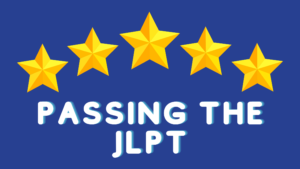Prepare for the JLPT N3 and N2 exam with this JLPT guide!
Learn all about the structure of the test, study techniques and more to successfully pass in 2024!
Are you ready to take the JLPT exam? This guide will help you understand the structure of the exam, prepare with effective study techniques and gain the confidence to pass this test, as well as what Toranomon Language School can offer you to help you with your studies.
Table of Contents
What is the JLPT?
What exactly is the JLPT? The JLPT, also known as the Japanese-Language Proficiency Test or 日本語能力試験, is an exam designed to measure the Japanese proficiency of non-native Japanese speakers. It’s commonly used by universities and employers both in and outside Japan, and it’s offered twice a year within Japan, as well as in a few other countries. Those who plan on living, working, or studying in Japan often take the JLPT exams to demonstrate their Japanese language skills.

What are the levels for the JLPT?
There are five different levels of the JLPT: N1, N2, N3, N4, and N5, with N5 being the most basic and N1 being the most advanced. The N4 and N5 levels test basic Japanese learned from a textbook, while N1 and N2 are much more advanced and test takers can usually hold their own in the language by that point. The N3 level is somewhere in between.
Here’s a closer look at the intermediate levels, N3 and N2:
- JLPT N3: Assesses intermediate skills for daily conversations, reading moderately complex texts, and solid grammar/vocabulary. It’s a stepping stone for further studies or work in Japanese-speaking environments.
JLPT N2: Signifies high proficiency, including comprehension of complex materials, detailed conversations, and nuanced grammar. It’s crucial for employment and daily interactions in Japan.

Why should I take the JLPT N3 and N2?
For those seeking employment in Japan, JLPT scores can be quite useful. Many jobs require N2 level minimum. Passing the N2 or N1 levels can even qualify individuals for preferential treatment when immigrating to Japan, or get you noticed by a potential employer.
While N2 certification is often required for jobs in Japan and international companies with Japanese ties, while N3 can open doors for various roles.
Overall, achieving JLPT N3 and N2 certifications provides significant advantages, including enhanced employment prospects in Japan and international companies, streamlined immigration processes, improved cultural integration for long-term stays, opportunities for career growth within Japanese industries, and personal development through language mastery and increased self-confidence.
An overview of the JLPT N3
The JLPT N3 exam targets learners with intermediate proficiency. It assumes you’ve mastered basic concepts like days of the week and numbers but are still refining your conversational skills. The test content includes:
Reading passages on everyday topics with basic kanji usage.
Listening and responding to questions about daily situations at a slightly slower pace than natural speech.
Usage of vocabulary at the N3 level, which expands beyond basic terms.
The exam is structured into three sections:
Vocabulary (including kanji, spelling, expressions, orthography, and paraphrasing).
Grammar and Reading (ordering sentences correctly, using appropriate verb forms, and comprehending short to mid-length passages).
Listening comprehension.
To succeed in the JLPT N3 exam, you’ll need to grasp around 3,000 vocabulary words and have knowledge of approximately 650 kanji characters.
This level encompasses everything covered in the N4 exam, with a broader vocabulary range that includes workplace, supermarket, and restaurant terms. If you’re seeking comprehensive preparation, consider TLS’s JLPT N3 course. For specific grammar help, explore our guide to Japanese particles and verb conjugations.
Check out our JLPT Intensive Course for N3
Here are some examples of grammar needed in order to nail the exam:
ーくらい:
- “~kurai” and “~” is a word used when you think lightly that “~” is not a big problem, it is a small thing
- English: at least
~っけ:
- “〜 kke” is used to confirm something the speaker can’t remember. This is also used when the speaker talks to theirself.
- V (ordinary form) + ikke
- A(normal form) + っけ
- NaA (normal form) + っけ
- N (normal form) + ikke
TLS offers a JLPT N3 preparation course which goes more in depth of grammatical points to consider– click here for details.
An overview of the JLPT N2
The JLPT N2 exam targets learners with advanced proficiency. It assumes you’re capable of engaging in sophisticated conversations, comprehending complex materials, and expressing ideas fluently. The test content includes:
Reading Comprehension: Analyzing and understanding various written materials, including essays, articles, and narratives, with advanced kanji usage.
Listening Comprehension: Listening to and comprehending spoken Japanese across different contexts and speeds, including formal speeches, interviews, and dialogues.
Grammar and Vocabulary: Demonstrating mastery of advanced grammar structures, idiomatic expressions, and nuanced vocabulary appropriate for professional and academic settings.
Understanding Cultural Context: Interpreting cultural nuances, formalities, and social etiquettes embedded within written and spoken content.
To succeed in the JLPT N2 exam, you’ll need to grasp around 6,000 vocabulary words and have knowledge of approximately 1,000 kanji characters.
The JLPT N2 exam is structured as follows:
Listening Comprehension: About 50 minutes, 34-36 questions. Involves listening to conversations and answering comprehension questions.
Language Knowledge (Vocabulary / Grammar) and Reading: Around 105 minutes, roughly 70 questions. Language knowledge section tests vocabulary and grammar proficiency. Reading section requires understanding written materials and answering related questions.
Vocab and kanji are foremost the important factor, then grammar in the N2 Level.
TLS offers a specialized JLPT N2 preparation course tailored to help you navigate the exam’s complexities and challenges. For further assistance with advanced grammar structures, verb conjugations, and comprehensive study materials, consider enrolling in our private lessons for targeted and personalized guidance.

How is the JLPT N3 & N2 scored? What’s the pass mark?
JLPT N3 Scoring:
Total Score Range: 0 to 180 points
Sections: Listening: 0-60 points
- Language Knowledge (Vocabulary): 0-60 points
- Language Knowledge (Grammar) & Reading: 0-60 points
Passing Score: 95 points (at least 19 points in each section)
JLPT N2 Scoring:
Total Score Range: 0 to 180 points
Sections:
Language Knowledge (Vocabulary/Grammar): 0-60 points
Reading Comprehension: 0-60 points
Listening Comprehension: 0-60 points
Passing Score: 90 points (at least 19 points in each section)
How long is the exam?
JLPT N3 Duration:
Listening Comprehension: Approximately 40 minutes
Language Knowledge (Vocabulary): Approximately 30 minutes
Language Knowledge (Grammar) & Reading: Approximately 70 minutes
Total Exam Duration: Around 140 minutes (2 hours and 20 minutes)
JLPT N2 Duration:
Listening Comprehension: Approximately 50 minutes
Language Knowledge (Vocabulary/Grammar) and Reading: Approximately 105 minutes
Total Exam Duration: Around 155 minutes (2 hours and 35 minutes)
Here are Some Common Issues to Keep in Mind
(1) difficulty with Kanji
(2) not knowing vocabulary
(3) not knowing grammar
(4) not being used to long sentences / not being used to written language
(5) not knowing how to solve puzzles.
How to register for 2024
Next Test Date: Sunday July 7, 2024
Application Method: Apply using the MyJLPT JLPT Application page after registering with MyJLPT on the JLPT website of Japan Educational Exchanges and Services (JEES).
Test Fee: 7,500 yen
Payment Methods: Credit card, bank transfer, payment at a convenience store.
After you register, you will receive more information in the post.
For more information, visit the JLPT Official Website. https://www.jlpt.jp/e/

